-
 Train to Win
Train to Win A propogandic pamphlet advertising Evening courses at RIT in 1942. Amidst WWII, this pamphlet boasts patriotic colors and a forceful tagline--"TRAIN TO WIN".
-
 Share the Meat
Share the Meat Evening School Course Offerings--Share the Meat! A course that specializes in the care and preparation of different meats, including topics such as Glands and Organs, ca. 1941-43.
-
 A Cooperative Community Program
A Cooperative Community Program Evening School Course Offerings Presents: Training For Defense, a Cooperative Community Program sponsored by Red Cross.
-
 Blazing New Trails - The Biography of a Pioneer in Education (Graph Showing the Historic Genealogy of Rochester Athenaeum & Mechanics Institute)
Blazing New Trails - The Biography of a Pioneer in Education (Graph Showing the Historic Genealogy of Rochester Athenaeum & Mechanics Institute) RIT has been a constantly evolving entity since the creation of the Rochester Literary Company in 1822, and it is still evolving to this day. Its genealogy reveals a continuous adjustment of services to meet community needs.
-
 Strategic Planning Meeting Results, 1934
Strategic Planning Meeting Results, 1934 During a strategic planning meeting with the current president of the institution, board of directors’ members, deans, and higher administrators, the general responsibilities of the Rochester Athenaeum and Mechanics Institute was discussed. Among the conclusions made regarding the trajectory of the institution, it was determined that the Rochester Athenaeum and mechanics institute would not grant full degree programs out of concern for limiting the freedom of individualized plan of study which had, historically, been supported by the institute.
-
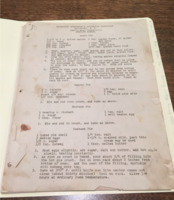 Family Meal Preparation
Family Meal Preparation Several sheets of recipes including a variety of meals and desserts. From a Family Meal Preparation course offered by RIT's Evening School.
-
 Applied Art Courses 1931 - 1932
Applied Art Courses 1931 - 1932 Applied Art courses applied to one of the following areas of industry: architecture, fine arts, illustration, craftsmanship (especially metal), and home life. By 1932, the offerings of the Applied Arts courses had expanded from basic classes such as Architectural Drawing and Structural Drafting to include courses for electrical diagram drawing, appealing more to the growing population of who would eventually become electrical engineers. The spread of these course offerings ensured at the time that both men and women would be interested in enrolling. Course tuition fees range from $8 to $12.
-
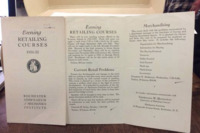 1931-32 Retailing Courses Coursebook
1931-32 Retailing Courses Coursebook By 1931-32, Georgiana W. Hathaway, long time retail distribution professor, was the supervisor of the newly redesigned "retailing courses" offered by the Rochester Athenaeum and Mechanic's Institute. These courses took the former 3 to 5 retail distribution courses and condensed them into two- "Current Retail Problems" and "Merchandising"- the later of which is now a profession in its own right. Topics for the merchandising course include mark-ups/downs, the 'buying contract', and inventories.
-
 The Pictorial Outline of Courses Booklet in the Rochester Athenaeum & Mechanics Institute (1929-1930)
The Pictorial Outline of Courses Booklet in the Rochester Athenaeum & Mechanics Institute (1929-1930) The front page of the pictorial outline of courses booklet in the Rochester Athenaeum & Mechanics Institute (1929-1930). This booklet offered the programs and these courses on the institution, as well as the housing and tuition costs.
-
 Evening Applied Art Courses 1928 - 1929
Evening Applied Art Courses 1928 - 1929 Courses were also suggested in the other areas of the college (technical term for department/college at the time not known), such as Home Economics, Industrial Arts, and Retailing. Applied Art courses applied to one of the following areas of industry: architecture, fine arts, illustration, craftsmanship (especially metal), and home life. Moreover, this is the first instance of photography being offered, which is especially of interest to Rochesterians because photography eventually became the major industry of the Rochester area and still leaves its mark on the university today. The spread of these course offerings ensured at the time that both men and women would be interested in enrolling. Course tuition fees range from $5 to $10.
-
 Co-operative Industrial Chemistry Course Brochure of Rochester Athenaeum and Mechanics Institute (1928-1929)
Co-operative Industrial Chemistry Course Brochure of Rochester Athenaeum and Mechanics Institute (1928-1929) This brochure outlined the courses under Co-operative Industrial Chemistry in Rochester Athenaeum and Mechanics Institute (1928-1929).
-
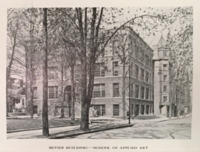 Brochure of Craft Course in the School of Applied Art at the Mechanics Institute (1928-1929)
Brochure of Craft Course in the School of Applied Art at the Mechanics Institute (1928-1929) "The aim of this course is to prepare students of special ability to enter the field of Art in industry as trained craft workers." the opened brochure of Craft Course in School of Applied Art in Mechanics Institute (1928-1929).
-
 Retail Distribution Handout
Retail Distribution Handout The course descriptions handout for the Mechanics Institute Evening School of Retail Distribution. This handout was a tri-fold brochure where the last page was a tear out application. For the application, you had to list your desired courses, name, and then the person's position in whatever department in whatever store they worked at. This shows an intense focus on educating adults already in industry, especially aimed towards women. Offered courses include "Psychology of Handling People" (tuition fee: $8), "Psychology of Salesmanship" (tuition fee: $8), "Current Style Analysis" (tuition fee: $5) and "Store Organization and Management" (tuition fee: $8).
-
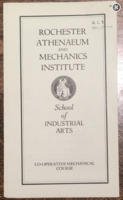 Co-operative Mechanical Course: Rochester Athenaeum and Mechanics Institute: School of Industrial Arts (1928-1929)
Co-operative Mechanical Course: Rochester Athenaeum and Mechanics Institute: School of Industrial Arts (1928-1929) The brochure of Co-operative Mechanical Course in School of Industrial Arts in Rochester Athenaeum and Mechanics Institute (1928-1929)
-
 Co-operative Courses: Rochester Athenaeum And Mechanic's Institute: 1927-1928
Co-operative Courses: Rochester Athenaeum And Mechanic's Institute: 1927-1928 An opened brochure of Co-operative Courses (1928) By Rochester Athenaeum and Mechanics Institute.
-
 Rochester Athenaeum & Mechanics Institute: Home Economics (1927-28)
Rochester Athenaeum & Mechanics Institute: Home Economics (1927-28) The aim of the School of Home Economics was to give to women the training that enabled them to become not only "good citizens", but "good homemakers" as well.
-
 School of Home Economics: One Year Course in Costuming 1927-1928
School of Home Economics: One Year Course in Costuming 1927-1928 Rochester Athenaeum and Mechanics Institute: School of Home Economics: One Year Course in Costuming 1927-1928 The details based on One Year Course in Costuming. The course was planned to meet the needs of young women who aim to enter the costume trade.
-
 1927-28 Evening Retail Distribution Coursebook
1927-28 Evening Retail Distribution Coursebook In 1927-28 course content for the evening retail distribution courses began to shift from the more artistic and aesthetic courses seen in previous catalogs, towards more people and economically driven courses, such as the "Psychology of Handling People" or the "Psychology of Salesmanship." Another change this year was an addition to the course book of a removable interest card for perspective students to mail to the Athenaeum to receive more information on the courses that interested them.
-
 Training Helps in Store Experience
Training Helps in Store Experience One of several evening courses that retail distribution students could take at the Rochester Athenaeum and Mechanic's Institute during the 1920s was Psychology of Salesmanship, which trained students in methods of efficiently and politely waiting on the public at department stores and other shops, as seen in this photograph from the 1927-28 evening retail distribution courses course book. Other courses on offer that year included Current Style Analysis and Store Organization and Management.
-
 Evening Applied Art Courses 1926 - 1927
Evening Applied Art Courses 1926 - 1927 Courses were offered from the end of September to the middle of June, with holidays given to students for Thanksgiving, Christmas, Presidents' Day, and Memorial Day. Applied Art courses applied to one of the following areas of industry: architecture, fine arts, illustration, craftsmanship (especially metal), and home life. The spread of these course offerings ensured at the time that both men and women would be interested in enrolling. Course tuition fees range from $5 to $10. All courses started at 7:30 PM.
-
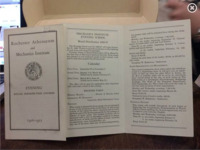 1926-27 Evening Retail Distribution Course Book
1926-27 Evening Retail Distribution Course Book One interesting course offering from the 1926-27 evening retail distribution course book is a class entitled "Everyday English." Topics for discussion included "Improving Our Vocabularies" and "Aids to Correct Spelling" both vital skills for salespeople who were supposed to convince people to buy their products in a time before television infomercials. Other useful courses included "Color and Design" and "Handling People," descriptions for which were printed on the inverse of this brochure.
-
 Homemaking Course
Homemaking Course Description of a four unit 'Homemaking Course' in the 1925-27 Rochester Athenaeum and Mechanics Institute Evening Home Economics Courses book. Courses such as this reflected the Athenaeum's goal with respect to their evening courses-- that people were not necessarily coming to the Athenaeum to earn a degree or become certified as people attending RIT do today, but to better themselves. And this meant betterment not only in the workplace, but in the home as well.
-
1921 Evening School Program
An Evening School program from 1921 includes examples of the types of problems that will be covered Trigonometry and Applied Elementary Mathematics.
-
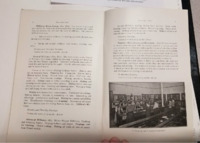 RIT Evening School Women's Classes Pamphlet
RIT Evening School Women's Classes Pamphlet RIT's commitment to their mission of continuing education involved women as well as men. In addition to courses for professions typically pursued by men, the institute also held courses for jobs held by women. Women in the workforce could take evening classes to increase their career proficiency in industries such as the textiles and millenary industry. This 1916-1917 informational pamphlet contains information regarding evening classes in millenary and textiles. It contains outlines of the courses as well as a photo of an ongoing textiles class in the textile laboratory.
-
 Department Of Household Arts Courses
Department Of Household Arts Courses In the Department of Household Arts, the women of Rochester continued to take evening classes at the Mechanics Institute for the school year from September 20, 1915- April 14, 1916. These classes included General Cookery, Invalid Cookery, Embroidery, Buttonhole making, and more. These classes ranged from 14 weeks to a full 28 weeks and were priced anywhere from $3.00 to $10.00 for the evening classes.
 Train to Win A propogandic pamphlet advertising Evening courses at RIT in 1942. Amidst WWII, this pamphlet boasts patriotic colors and a forceful tagline--"TRAIN TO WIN".
Train to Win A propogandic pamphlet advertising Evening courses at RIT in 1942. Amidst WWII, this pamphlet boasts patriotic colors and a forceful tagline--"TRAIN TO WIN". Share the Meat Evening School Course Offerings--Share the Meat! A course that specializes in the care and preparation of different meats, including topics such as Glands and Organs, ca. 1941-43.
Share the Meat Evening School Course Offerings--Share the Meat! A course that specializes in the care and preparation of different meats, including topics such as Glands and Organs, ca. 1941-43. A Cooperative Community Program Evening School Course Offerings Presents: Training For Defense, a Cooperative Community Program sponsored by Red Cross.
A Cooperative Community Program Evening School Course Offerings Presents: Training For Defense, a Cooperative Community Program sponsored by Red Cross. Blazing New Trails - The Biography of a Pioneer in Education (Graph Showing the Historic Genealogy of Rochester Athenaeum & Mechanics Institute) RIT has been a constantly evolving entity since the creation of the Rochester Literary Company in 1822, and it is still evolving to this day. Its genealogy reveals a continuous adjustment of services to meet community needs.
Blazing New Trails - The Biography of a Pioneer in Education (Graph Showing the Historic Genealogy of Rochester Athenaeum & Mechanics Institute) RIT has been a constantly evolving entity since the creation of the Rochester Literary Company in 1822, and it is still evolving to this day. Its genealogy reveals a continuous adjustment of services to meet community needs. Strategic Planning Meeting Results, 1934 During a strategic planning meeting with the current president of the institution, board of directors’ members, deans, and higher administrators, the general responsibilities of the Rochester Athenaeum and Mechanics Institute was discussed. Among the conclusions made regarding the trajectory of the institution, it was determined that the Rochester Athenaeum and mechanics institute would not grant full degree programs out of concern for limiting the freedom of individualized plan of study which had, historically, been supported by the institute.
Strategic Planning Meeting Results, 1934 During a strategic planning meeting with the current president of the institution, board of directors’ members, deans, and higher administrators, the general responsibilities of the Rochester Athenaeum and Mechanics Institute was discussed. Among the conclusions made regarding the trajectory of the institution, it was determined that the Rochester Athenaeum and mechanics institute would not grant full degree programs out of concern for limiting the freedom of individualized plan of study which had, historically, been supported by the institute. Family Meal Preparation Several sheets of recipes including a variety of meals and desserts. From a Family Meal Preparation course offered by RIT's Evening School.
Family Meal Preparation Several sheets of recipes including a variety of meals and desserts. From a Family Meal Preparation course offered by RIT's Evening School. Applied Art Courses 1931 - 1932 Applied Art courses applied to one of the following areas of industry: architecture, fine arts, illustration, craftsmanship (especially metal), and home life. By 1932, the offerings of the Applied Arts courses had expanded from basic classes such as Architectural Drawing and Structural Drafting to include courses for electrical diagram drawing, appealing more to the growing population of who would eventually become electrical engineers. The spread of these course offerings ensured at the time that both men and women would be interested in enrolling. Course tuition fees range from $8 to $12.
Applied Art Courses 1931 - 1932 Applied Art courses applied to one of the following areas of industry: architecture, fine arts, illustration, craftsmanship (especially metal), and home life. By 1932, the offerings of the Applied Arts courses had expanded from basic classes such as Architectural Drawing and Structural Drafting to include courses for electrical diagram drawing, appealing more to the growing population of who would eventually become electrical engineers. The spread of these course offerings ensured at the time that both men and women would be interested in enrolling. Course tuition fees range from $8 to $12. 1931-32 Retailing Courses Coursebook By 1931-32, Georgiana W. Hathaway, long time retail distribution professor, was the supervisor of the newly redesigned "retailing courses" offered by the Rochester Athenaeum and Mechanic's Institute. These courses took the former 3 to 5 retail distribution courses and condensed them into two- "Current Retail Problems" and "Merchandising"- the later of which is now a profession in its own right. Topics for the merchandising course include mark-ups/downs, the 'buying contract', and inventories.
1931-32 Retailing Courses Coursebook By 1931-32, Georgiana W. Hathaway, long time retail distribution professor, was the supervisor of the newly redesigned "retailing courses" offered by the Rochester Athenaeum and Mechanic's Institute. These courses took the former 3 to 5 retail distribution courses and condensed them into two- "Current Retail Problems" and "Merchandising"- the later of which is now a profession in its own right. Topics for the merchandising course include mark-ups/downs, the 'buying contract', and inventories. The Pictorial Outline of Courses Booklet in the Rochester Athenaeum & Mechanics Institute (1929-1930) The front page of the pictorial outline of courses booklet in the Rochester Athenaeum & Mechanics Institute (1929-1930). This booklet offered the programs and these courses on the institution, as well as the housing and tuition costs.
The Pictorial Outline of Courses Booklet in the Rochester Athenaeum & Mechanics Institute (1929-1930) The front page of the pictorial outline of courses booklet in the Rochester Athenaeum & Mechanics Institute (1929-1930). This booklet offered the programs and these courses on the institution, as well as the housing and tuition costs. Evening Applied Art Courses 1928 - 1929 Courses were also suggested in the other areas of the college (technical term for department/college at the time not known), such as Home Economics, Industrial Arts, and Retailing. Applied Art courses applied to one of the following areas of industry: architecture, fine arts, illustration, craftsmanship (especially metal), and home life. Moreover, this is the first instance of photography being offered, which is especially of interest to Rochesterians because photography eventually became the major industry of the Rochester area and still leaves its mark on the university today. The spread of these course offerings ensured at the time that both men and women would be interested in enrolling. Course tuition fees range from $5 to $10.
Evening Applied Art Courses 1928 - 1929 Courses were also suggested in the other areas of the college (technical term for department/college at the time not known), such as Home Economics, Industrial Arts, and Retailing. Applied Art courses applied to one of the following areas of industry: architecture, fine arts, illustration, craftsmanship (especially metal), and home life. Moreover, this is the first instance of photography being offered, which is especially of interest to Rochesterians because photography eventually became the major industry of the Rochester area and still leaves its mark on the university today. The spread of these course offerings ensured at the time that both men and women would be interested in enrolling. Course tuition fees range from $5 to $10. Co-operative Industrial Chemistry Course Brochure of Rochester Athenaeum and Mechanics Institute (1928-1929) This brochure outlined the courses under Co-operative Industrial Chemistry in Rochester Athenaeum and Mechanics Institute (1928-1929).
Co-operative Industrial Chemistry Course Brochure of Rochester Athenaeum and Mechanics Institute (1928-1929) This brochure outlined the courses under Co-operative Industrial Chemistry in Rochester Athenaeum and Mechanics Institute (1928-1929). Brochure of Craft Course in the School of Applied Art at the Mechanics Institute (1928-1929) "The aim of this course is to prepare students of special ability to enter the field of Art in industry as trained craft workers." the opened brochure of Craft Course in School of Applied Art in Mechanics Institute (1928-1929).
Brochure of Craft Course in the School of Applied Art at the Mechanics Institute (1928-1929) "The aim of this course is to prepare students of special ability to enter the field of Art in industry as trained craft workers." the opened brochure of Craft Course in School of Applied Art in Mechanics Institute (1928-1929). Retail Distribution Handout The course descriptions handout for the Mechanics Institute Evening School of Retail Distribution. This handout was a tri-fold brochure where the last page was a tear out application. For the application, you had to list your desired courses, name, and then the person's position in whatever department in whatever store they worked at. This shows an intense focus on educating adults already in industry, especially aimed towards women. Offered courses include "Psychology of Handling People" (tuition fee: $8), "Psychology of Salesmanship" (tuition fee: $8), "Current Style Analysis" (tuition fee: $5) and "Store Organization and Management" (tuition fee: $8).
Retail Distribution Handout The course descriptions handout for the Mechanics Institute Evening School of Retail Distribution. This handout was a tri-fold brochure where the last page was a tear out application. For the application, you had to list your desired courses, name, and then the person's position in whatever department in whatever store they worked at. This shows an intense focus on educating adults already in industry, especially aimed towards women. Offered courses include "Psychology of Handling People" (tuition fee: $8), "Psychology of Salesmanship" (tuition fee: $8), "Current Style Analysis" (tuition fee: $5) and "Store Organization and Management" (tuition fee: $8). Co-operative Mechanical Course: Rochester Athenaeum and Mechanics Institute: School of Industrial Arts (1928-1929) The brochure of Co-operative Mechanical Course in School of Industrial Arts in Rochester Athenaeum and Mechanics Institute (1928-1929)
Co-operative Mechanical Course: Rochester Athenaeum and Mechanics Institute: School of Industrial Arts (1928-1929) The brochure of Co-operative Mechanical Course in School of Industrial Arts in Rochester Athenaeum and Mechanics Institute (1928-1929) Co-operative Courses: Rochester Athenaeum And Mechanic's Institute: 1927-1928 An opened brochure of Co-operative Courses (1928) By Rochester Athenaeum and Mechanics Institute.
Co-operative Courses: Rochester Athenaeum And Mechanic's Institute: 1927-1928 An opened brochure of Co-operative Courses (1928) By Rochester Athenaeum and Mechanics Institute. Rochester Athenaeum & Mechanics Institute: Home Economics (1927-28) The aim of the School of Home Economics was to give to women the training that enabled them to become not only "good citizens", but "good homemakers" as well.
Rochester Athenaeum & Mechanics Institute: Home Economics (1927-28) The aim of the School of Home Economics was to give to women the training that enabled them to become not only "good citizens", but "good homemakers" as well. School of Home Economics: One Year Course in Costuming 1927-1928 Rochester Athenaeum and Mechanics Institute: School of Home Economics: One Year Course in Costuming 1927-1928 The details based on One Year Course in Costuming. The course was planned to meet the needs of young women who aim to enter the costume trade.
School of Home Economics: One Year Course in Costuming 1927-1928 Rochester Athenaeum and Mechanics Institute: School of Home Economics: One Year Course in Costuming 1927-1928 The details based on One Year Course in Costuming. The course was planned to meet the needs of young women who aim to enter the costume trade. 1927-28 Evening Retail Distribution Coursebook In 1927-28 course content for the evening retail distribution courses began to shift from the more artistic and aesthetic courses seen in previous catalogs, towards more people and economically driven courses, such as the "Psychology of Handling People" or the "Psychology of Salesmanship." Another change this year was an addition to the course book of a removable interest card for perspective students to mail to the Athenaeum to receive more information on the courses that interested them.
1927-28 Evening Retail Distribution Coursebook In 1927-28 course content for the evening retail distribution courses began to shift from the more artistic and aesthetic courses seen in previous catalogs, towards more people and economically driven courses, such as the "Psychology of Handling People" or the "Psychology of Salesmanship." Another change this year was an addition to the course book of a removable interest card for perspective students to mail to the Athenaeum to receive more information on the courses that interested them. Training Helps in Store Experience One of several evening courses that retail distribution students could take at the Rochester Athenaeum and Mechanic's Institute during the 1920s was Psychology of Salesmanship, which trained students in methods of efficiently and politely waiting on the public at department stores and other shops, as seen in this photograph from the 1927-28 evening retail distribution courses course book. Other courses on offer that year included Current Style Analysis and Store Organization and Management.
Training Helps in Store Experience One of several evening courses that retail distribution students could take at the Rochester Athenaeum and Mechanic's Institute during the 1920s was Psychology of Salesmanship, which trained students in methods of efficiently and politely waiting on the public at department stores and other shops, as seen in this photograph from the 1927-28 evening retail distribution courses course book. Other courses on offer that year included Current Style Analysis and Store Organization and Management. Evening Applied Art Courses 1926 - 1927 Courses were offered from the end of September to the middle of June, with holidays given to students for Thanksgiving, Christmas, Presidents' Day, and Memorial Day. Applied Art courses applied to one of the following areas of industry: architecture, fine arts, illustration, craftsmanship (especially metal), and home life. The spread of these course offerings ensured at the time that both men and women would be interested in enrolling. Course tuition fees range from $5 to $10. All courses started at 7:30 PM.
Evening Applied Art Courses 1926 - 1927 Courses were offered from the end of September to the middle of June, with holidays given to students for Thanksgiving, Christmas, Presidents' Day, and Memorial Day. Applied Art courses applied to one of the following areas of industry: architecture, fine arts, illustration, craftsmanship (especially metal), and home life. The spread of these course offerings ensured at the time that both men and women would be interested in enrolling. Course tuition fees range from $5 to $10. All courses started at 7:30 PM. 1926-27 Evening Retail Distribution Course Book One interesting course offering from the 1926-27 evening retail distribution course book is a class entitled "Everyday English." Topics for discussion included "Improving Our Vocabularies" and "Aids to Correct Spelling" both vital skills for salespeople who were supposed to convince people to buy their products in a time before television infomercials. Other useful courses included "Color and Design" and "Handling People," descriptions for which were printed on the inverse of this brochure.
1926-27 Evening Retail Distribution Course Book One interesting course offering from the 1926-27 evening retail distribution course book is a class entitled "Everyday English." Topics for discussion included "Improving Our Vocabularies" and "Aids to Correct Spelling" both vital skills for salespeople who were supposed to convince people to buy their products in a time before television infomercials. Other useful courses included "Color and Design" and "Handling People," descriptions for which were printed on the inverse of this brochure. Homemaking Course Description of a four unit 'Homemaking Course' in the 1925-27 Rochester Athenaeum and Mechanics Institute Evening Home Economics Courses book. Courses such as this reflected the Athenaeum's goal with respect to their evening courses-- that people were not necessarily coming to the Athenaeum to earn a degree or become certified as people attending RIT do today, but to better themselves. And this meant betterment not only in the workplace, but in the home as well.
Homemaking Course Description of a four unit 'Homemaking Course' in the 1925-27 Rochester Athenaeum and Mechanics Institute Evening Home Economics Courses book. Courses such as this reflected the Athenaeum's goal with respect to their evening courses-- that people were not necessarily coming to the Athenaeum to earn a degree or become certified as people attending RIT do today, but to better themselves. And this meant betterment not only in the workplace, but in the home as well. RIT Evening School Women's Classes Pamphlet RIT's commitment to their mission of continuing education involved women as well as men. In addition to courses for professions typically pursued by men, the institute also held courses for jobs held by women. Women in the workforce could take evening classes to increase their career proficiency in industries such as the textiles and millenary industry. This 1916-1917 informational pamphlet contains information regarding evening classes in millenary and textiles. It contains outlines of the courses as well as a photo of an ongoing textiles class in the textile laboratory.
RIT Evening School Women's Classes Pamphlet RIT's commitment to their mission of continuing education involved women as well as men. In addition to courses for professions typically pursued by men, the institute also held courses for jobs held by women. Women in the workforce could take evening classes to increase their career proficiency in industries such as the textiles and millenary industry. This 1916-1917 informational pamphlet contains information regarding evening classes in millenary and textiles. It contains outlines of the courses as well as a photo of an ongoing textiles class in the textile laboratory. Department Of Household Arts Courses In the Department of Household Arts, the women of Rochester continued to take evening classes at the Mechanics Institute for the school year from September 20, 1915- April 14, 1916. These classes included General Cookery, Invalid Cookery, Embroidery, Buttonhole making, and more. These classes ranged from 14 weeks to a full 28 weeks and were priced anywhere from $3.00 to $10.00 for the evening classes.
Department Of Household Arts Courses In the Department of Household Arts, the women of Rochester continued to take evening classes at the Mechanics Institute for the school year from September 20, 1915- April 14, 1916. These classes included General Cookery, Invalid Cookery, Embroidery, Buttonhole making, and more. These classes ranged from 14 weeks to a full 28 weeks and were priced anywhere from $3.00 to $10.00 for the evening classes.